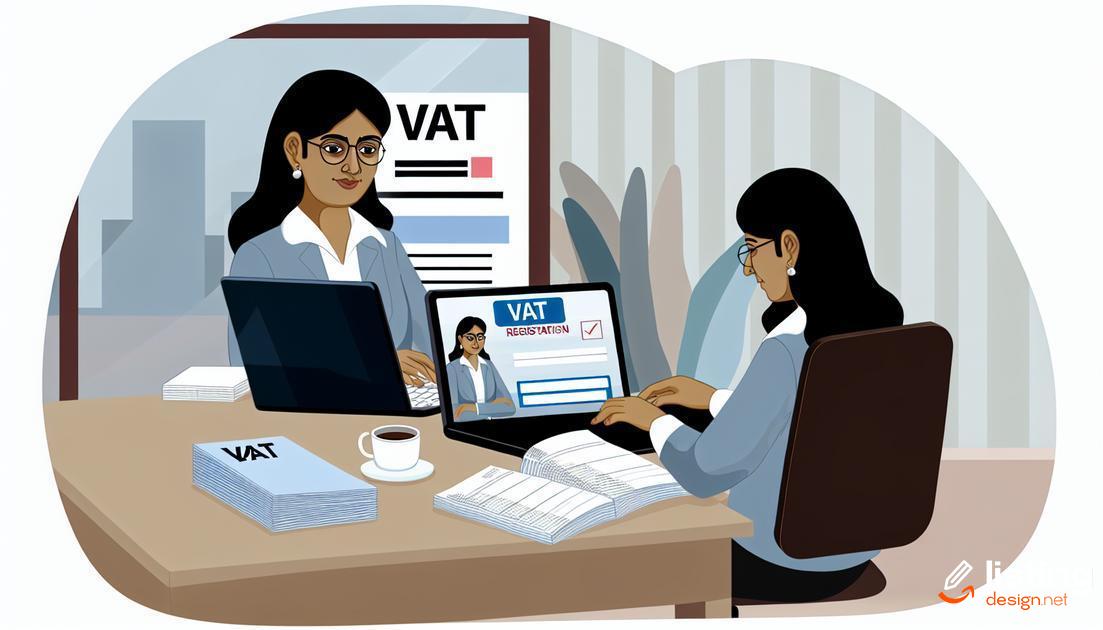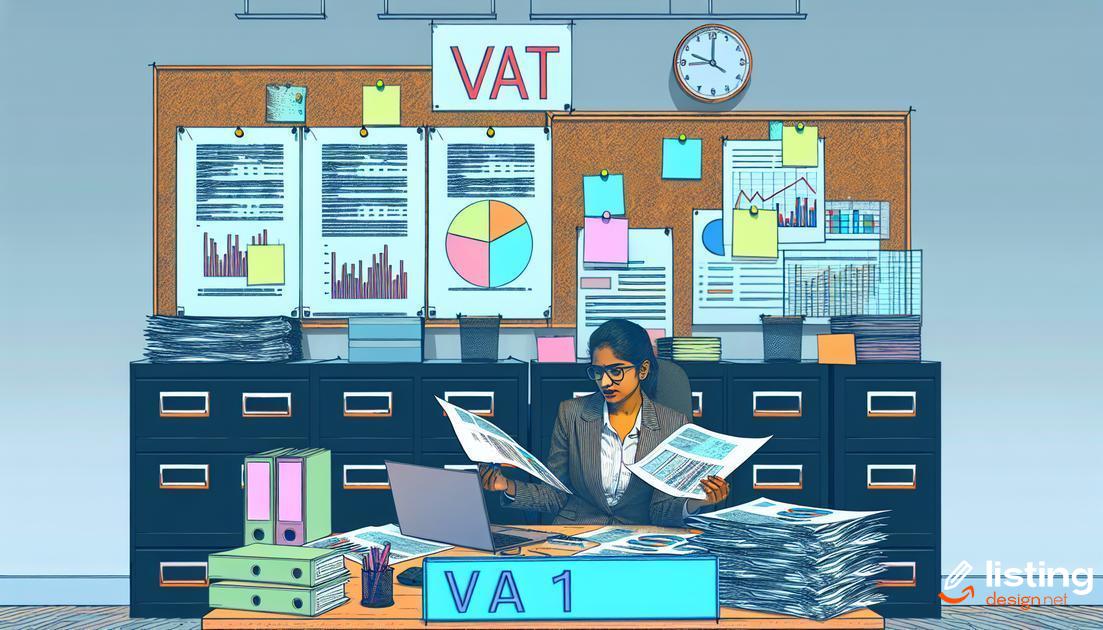As an Amazon seller, VAT compliance is essential for the smooth operation of your business. In this guide, we’ll cover key aspects like understanding VAT, avoiding common mistakes, and staying updated with the latest regulations. By the end, you’ll have a clear idea of how to manage VAT effectively and keep your online business compliant.
Table of Contents
Understanding VAT for Amazon Sellers
VAT (Value Added Tax) is a consumption tax levied on goods and services. For Amazon sellers, understanding VAT is crucial to ensure compliance and avoid unnecessary penalties. VAT is calculated based on the value added at each stage of the production and distribution process.
VAT Registration: It is imperative for Amazon sellers to register for VAT once they surpass the threshold set by their local tax authorities. This registration enables sellers to charge and collect VAT from their customers.
VAT Calculation: Calculating VAT on your sales involves applying the correct VAT rate to the selling price of your goods or services. It’s important to use the appropriate rate as it varies by product type and country.
Filing VAT Returns: As a registered Amazon seller, you are required to file periodic VAT returns. These returns provide details on the VAT collected and paid, ensuring proper remittance to the tax authorities.
Understanding these key aspects of VAT helps Amazon sellers maintain compliance and avoid potential financial repercussions.
Common VAT Mistakes to Avoid

Incorrect VAT Registrations
One of the most common mistakes Amazon sellers make is not registering for VAT in the appropriate countries. Make sure you understand the VAT registration requirements for each country where you have a taxable presence.
Improper Calculations
Accurately calculating VAT on your sales is crucial. Use automated tools to ensure VAT is added correctly to invoices. Avoid guesswork to prevent discrepancies.
Missed Deadlines
Missing VAT filing deadlines can lead to hefty fines and penalties. Set reminders and use a reliable VAT filing service to stay on top of your obligations.
Poor Record-Keeping
Maintaining accurate and organized records of transactions, VAT collected, and VAT paid is essential. Inadequate record-keeping can lead to errors during audits.
Ignoring Cross-Border VAT Rules
Each country has different VAT rules for cross-border sales. Ensure compliance by understanding the VAT laws in each market you operate in to avoid penalties.
Neglecting VAT Return Reconciliation
Ensure that your VAT returns match your sales records. Discrepancies can trigger audits and inquiries that can be time-consuming and costly.
Overlooking VAT on Imports
If you are importing goods, remember to account for VAT on these imports. Import VAT can be reclaimed but must be correctly documented and declared.
Importance of VAT Compliance
Ensuring VAT compliance is crucial for Amazon sellers to avoid fines and disruptions in trading. Accurate VAT handling helps maintain a professional and trustworthy presence in the marketplace. Proper VAT management builds customer confidence as buyers rely on merchants to handle taxes correctly. Keeping up with VAT obligations means maintaining transparent pricing, enhancing the reputation, and fostering long-term business growth.
Non-compliance can lead to severe financial repercussions, including penalties, interest on unpaid taxes, and even legal actions. Consistency in VAT compliance demonstrates a commitment to abiding by legal standards, which is essential in a competitive market. Furthermore, adhering to VAT regulations ensures eligibility for tax deductions, ultimately optimizing profit margins.
VAT compliance also facilitates smoother international transactions. In an environment where cross-border sales are commonplace, correctly managing VAT can prevent delays at customs and reduce the risk of goods being held or returned. It streamlines business operations, making it easier to expand and manage an international customer base.
Effective VAT compliance involves continuous monitoring of changes in tax regulations. Staying updated with the latest rules avoids unexpected charges and adjusts pricing strategies accordingly. Ongoing education and awareness can be achieved through regular consultations with tax professionals or VAT specialists, who provide insights and guidance on best practices for VAT management.
Registering for VAT

Registering for VAT is a critical step for Amazon sellers to ensure compliance and avoid penalties. The process begins by determining if your business meets the VAT registration threshold in the country you are operating in. It’s essential to take into account both domestic and EU thresholds.
Gather Required Information
Before starting the registration process, prepare the necessary documents such as your business’s incorporation details, bank account information, and identification numbers. This will streamline the registration procedure and minimize delays.
Choose the Correct VAT Scheme
Different countries offer various VAT schemes, such as the standard VAT scheme or the flat rate scheme. Selecting the correct scheme that fits your business model is crucial. For instance, the flat rate scheme may simplify accounting for smaller businesses, while the standard scheme might be more suitable for larger operations.
Complete the Registration Form
Visit the tax authority’s website of the respective country to complete the VAT registration form. Ensure that all information provided is accurate and up-to-date. Incomplete or incorrect information can lead to delays or rejection of your application.
Obtain Your VAT Number
After submission, you will receive a confirmation from the tax authorities. They will issue a unique VAT number for your business. This number should be added to your Amazon seller account and included on all invoices issued to customers.
This detailed approach to registering for VAT can help you avoid common pitfalls and maintain compliance, ensuring smooth business operations on Amazon.
Calculating VAT on Sales
When it comes to calculating VAT on sales, it’s essential to follow precise steps to ensure compliance with tax regulations.
Firstly, determine the applicable VAT rate for your products. This varies by country and product type. Generally, the rates consist of standard, reduced, super reduced, and zero rates.
- Standard Rate: Commonly applied to most goods and services.
- Reduced Rate: Applied to certain goods and services like children’s car seats and home energy.
- Super Reduced Rate: Used for specific goods, often essential items such as some food products.
- Zero Rate: Applied to goods and services that are VAT-taxable but the rate is 0%.
To calculate VAT, use the following formula:
VAT Amount = (Net Price x VAT Rate) / 100For instance, if the net price of an item is $100 and the VAT rate is 20%, the VAT amount would be calculated as:
VAT Amount = ($100 x 20) / 100 = $20This means the total price including VAT would be $120.
Next, ensure all sales invoices include the VAT amount and your VAT number. This transparency helps in maintaining clear records and simplifies the filing of VAT returns.
Additionally, consider any VAT exemptions or special schemes applicable to your sales. For instance, the margin scheme for second-hand goods allows you to pay VAT only on the difference between the selling price and the purchase price.
Regularly update your knowledge of VAT rates and rules, as these can change and impact your calculations.
Keep detailed records of each calculation and sale to avoid inconsistencies and ensure you’re prepared for potential VAT inspections.
By following these steps, you can accurately calculate VAT on your sales, comply with legal requirements, and avoid costly mistakes.
Filing VAT Returns

When it comes to filing VAT returns, Amazon sellers must be diligent and accurate. This process typically involves the submission of detailed reports that outline all taxable sales and purchases within a given period.
Steps to File VAT Returns:
-
Collect Necessary Documentation:
Ensure you have all invoices, receipts, and other relevant documents for the reporting period.
-
Calculate VAT Due:
Tally the total VAT collected on sales and compare it to the VAT paid on purchases. The difference is your VAT liability.
-
Enter Data into VAT Portal:
Use the appropriate online portal to enter your data accurately. Double-check all entries to prevent errors.
-
Submit Before Deadline:
Adhere to the submission deadlines to avoid late filing penalties. It’s crucial to know your specific due dates as they may vary by region.
-
Payment:
Once the return is filed, pay any outstanding VAT amount due. Keep records of the payment confirmation.
Tip: Investing in accounting software can streamline the VAT filing process, reducing the risk of errors and saving time.
Remember, filing accurate and timely VAT returns is essential for maintaining compliance and avoiding costly penalties.
Cross-Border VAT Rules
When selling goods across borders, understanding the correct VAT rules is essential. Different countries have varied VAT regulations which can affect how much tax needs to be collected and paid.
Knowing Your Obligations
As an Amazon seller, you must determine the VAT rate in each country you are selling to. Countries within the EU typically have similar VAT processes, but rates and thresholds vary.
For example, if your sales exceed a certain threshold in a particular EU country, you may need to register for VAT there. This is known as ‘distance selling’ rules.
The Reverse Charge Mechanism
When selling B2B (Business to Business), the reverse charge mechanism might apply. This means the buyer is responsible for recording the VAT instead of you as the seller. This is prevalent in cross-border transactions within the EU.
Non-EU Sales
Selling to countries outside the EU introduces different complexities. For instance, sales to US customers typically do not include VAT, but you may need to comply with sales tax regulations in specific states.
Digital Goods vs Physical Goods
The VAT rules differ for digital goods compared to physical goods. Digital products sold to EU consumers generally require VAT to be charged based on the buyer’s location, regardless of your business location.
Import VAT
When importing goods into the EU, import VAT needs to be considered. This is typically paid at the border and may be reclaimable if you are VAT registered in the importing country.
Consequences of Non-Compliance
Failure to comply with cross-border VAT rules can result in significant fines and legal issues. Understanding these rules and applying them correctly is crucial for avoiding these potential pitfalls.
Keeping Accurate Records

Maintaining precise records is essential for VAT compliance. Ensure that all transactions, including sales, purchases, and VAT charged or paid, are systematically documented. Utilize accounting software that can automate the recording process while allowing easy access to historical data.
Regularly update your records to reflect current financial standings. This not only helps in accurate VAT filings but also in identifying discrepancies or potential issues early on.
Keep digital copies of all invoices and receipts. Store them in a structured manner to facilitate quick retrieval during audits or inspections. Organizing documents by date, transaction type, or customer name can significantly streamline this process.
Ensure compliance by conducting internal audits periodically. Review your records against VAT returns to confirm consistency and accuracy. Proactive checks can prevent costly errors and penalties.
Finally, familiarize yourself with the retention periods for tax records in your jurisdiction. Keeping accurate records over the required time frame ensures you are always prepared for any eventuality.
Dealing with VAT Inspections
Respond Promptly and Thoroughly: When notified of a VAT inspection, it’s critical to respond promptly. Ignoring such notices can lead to further complications and even penalties.
Organize Documentation: Ensure all your financial records, invoices, and VAT returns are well-organized. These documents should be easily accessible and complete.
Seek Professional Help: Consider hiring a VAT specialist who can guide you through the inspection process, provide expert advice, and ensure compliance with all regulations.
Prepare for On-Site Visits: VAT inspections might involve on-site visits. Be prepared to provide inspectors with access to your records, and be ready to answer questions about your VAT processes.
Inspectors might ask for explanations of discrepancies or request additional documents. Be cooperative and transparent to facilitate a smooth inspection process.
Penalties for Non-Compliance

Non-compliance with VAT regulations can lead to severe consequences for Amazon sellers. These penalties can vary significantly depending on the nature and severity of the infraction.
Fines and Interest
Sellers may incur fines and interest charges on unpaid VAT amounts. These can be a percentage of the outstanding VAT or a fixed sum per day overdue.
Additional Penalties
Repeated or severe non-compliance can result in more serious penalties, including administrative sanctions. These may involve restrictions on trading or even the suspension of your Amazon account.
Criminal Charges
In extreme cases, deliberate VAT evasion can lead to criminal charges. This could result in heavy fines or even imprisonment.
Impact on Reputation
Consistent non-compliance can damage a seller’s reputation. This can affect customer trust and ultimately impact sales. It is crucial to ensure VAT compliance to avoid these penalties and maintain a positive business standing on Amazon.
Hiring a VAT Specialist
When it comes to ensuring VAT compliance on platforms like Amazon, hiring a VAT specialist can be instrumental. A VAT specialist can navigate the complexities of various rules and regulations to ensure your business avoids costly errors. They possess in-depth knowledge about VAT codes, updated regulations, and compliance procedures. By outsourcing this responsibility, you can focus on other critical aspects of your business while the specialist handles VAT filings, registration, and accurate record-keeping.
VAT specialists often provide tailored solutions specific to your ecommerce operations. They can automate VAT calculations for your sales, ensuring the right amount is charged and remitted. Furthermore, they offer guidance on cross-border transactions, helping you understand the impact of different tax jurisdictions. This expertise can be invaluable in maintaining compliance and avoiding fines.
With new regulation changes frequently emerging, a specialist stays updated with the latest legal requirements. Their proactive approach ensures that your business is always operating within the legal framework, thus preventing potential penalties from tax authorities.
In summary, hiring a VAT specialist can save time, reduce stress, and protect your business from non-compliance risks. Their contributions are crucial for any Amazon seller aiming to maintain a smooth, compliant operation amidst the evolving landscape of VAT regulations.
Latest VAT Regulation Changes

Recent updates to VAT regulations can significantly impact Amazon sellers. Being aware of these changes is crucial for maintaining compliance.
Increased Thresholds
The thresholds for VAT registration in many countries have been revised upwards, which might offer some relief for small businesses. However, it’s important to verify the specific thresholds for each market you operate in.
Digital Reporting Requirements
Certain jurisdictions now require digital submission of VAT records and transaction data. This aims to improve transparency and reduce tax evasion. Sellers must ensure their accounting software is compliant with these new standards.
Changes to Tax Rates
Several countries have introduced changes to their VAT rates, which can significantly affect pricing strategies and profitability. It’s vital to stay informed of these rate changes and adjust your pricing accordingly.
New Cross-Border Rules
With the rise of e-commerce, many countries have revised their cross-border VAT regulations, impacting how VAT is collected on sales to international customers. Ensure you understand the rules for each country to avoid costly mistakes.
Data and Documentation
Updated regulations often require more detailed records and documentation for VAT-exempt transactions. Ensure your records are thorough and properly stored to facilitate smooth audits and inspections.
Penalties and Compliance
Non-compliance with the latest VAT regulations can result in significant penalties. Regularly review the regulations in each market you serve to ensure compliance and avoid fines that could impact your business.


